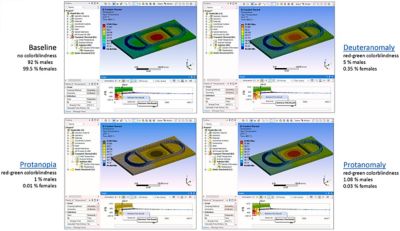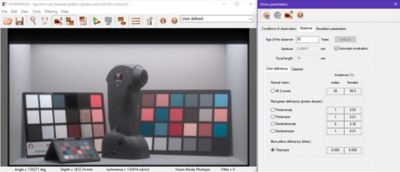-
United States -
United Kingdom -
India -
France -
Deutschland -
Italia -
日本 -
대한민국 -
中国 -
台灣
-
Ansys is committed to setting today's students up for success, by providing free simulation engineering software to students.
-
Ansys is committed to setting today's students up for success, by providing free simulation engineering software to students.
-
Ansys is committed to setting today's students up for success, by providing free simulation engineering software to students.
-
Contact Us -
Careers -
Students and Academic -
For United States and Canada
+1 844.462.6797
ANSYS BLOG
September 6, 2022
Simulation Helps Color Blind Drivers Navigate the Road Ahead
More than 300 million people are color blind worldwide. Statistically, men are at a much higher risk for color blindness — 1 in 12 men suffer from it, as opposed to just 1 in 200 women1. It’s a condition that can make daily tasks quite challenging, from reading traffic signals to identifying products or matching clothes. A colorblind driver can compensate by wearing special glasses or contact lenses, as well as smartphone apps that can help.
But what happens when you’re driving? It is legal for color blind people to drive in the United States as long as they can pass a drivers test, and being color blind does not inhibit most color blind people from driving. But reading a navigation screen is difficult when you can’t see the colors on your display — which is why automotive engineers looked to Ansys simulation specifically for help interpreting what a color-blind person sees, then applying it to create a more user-friendly display for drivers with visual color deficiencies.

The Ishihara test is the most widely used test for red-green color blindness. It consists of 38 color-dotted Ishihara plates that contain either a number or path-shaped design.
Have you ever wondered what it was like to be color blind, or what a color-blind person actually sees? For the color blind, the world isn’t always black and white; it’s about seeing colors differently. This difference in perception makes it more difficult to distinguish between certain colors. Red-green color blindness (the most common form) makes red indiscernible from green. Blue-yellow color blindness impacts the ability to distinguish between blue and green, or yellow and red. Monochromacy, or complete color blindness, is very rare, but is just what it sounds like: the inability to see color at all.
Typically our retinas contain three types of cones that respond to light at different wavelengths to help us perceive color: red-sensing cones, blue-sensing cones, and green-sensing cones. Most of us are born with approximately 6 million of them2, all of which enable us to see colors of various hues as light bounces off the objects surrounding us in everyday life. If you have red-green or blue-yellow color blindness, it’s because you lack specific photoreceptor cells called cones in the retinas of your eyes. Color blind people have fewer of these cones that normal, a condition that causes them to confuse colors.
Visualizing Inclusivity for Color Blind Drivers with Simulation
So, when was the last time you actually read a road map? Most of us rely on smartphone apps like Waze or GPS systems made visible through our vehicle infotainment displays. But certain colors in GPS displays, such as route guidelines or other markers, are not always visible to color blind people depending on the colors used. Laurent Fournier, lead electronics R&D engineer at Ansys, developed a color blindness feature within Ansys Speos optical systems software to help engineers validate optical designs that were more sensitive to drivers with color blindness.
Designing an in-vehicle display is a matter of ergonomics. Proper use of color can enhance user experience for all drivers, with or without visual impairments. To be impactful, the Speos feature needed to predict what color-blind people will see in response to numerous factors, such as display brightness, resolution, contrast, and illuminance in ambient lighting conditions — all of which can have an impact on how color is perceived.

Visual representation of color blindness using Ansys simulation software
Fournier’s team used Ansys SpaceClaim 3D computer-aided design (CAD) modeling software in combination with Speos to do the direct modeling, and then added an extra optical layer on top of it including relevant optical properties, sensors, and light sources needed to simulate different environments. Speos enables accurate simulation of source emission, of light propagation, of light interaction with surfaces, and of light detection via spectral management. The Speos human eye model then transforms spectral luminance information into perceived visual information. This model, based on certain physiological aspects, helps engineers to understand how colors would appear to the naked eye — taking into account the response of the eye to light levels, color, contrast, as well as rapid changes in surrounding luminosity in accordance with the response of the retina.
“In a vehicle interior, you have colors and light impacting the experience from every direction,” says Fournier. “Using the Speos feature not only helps us to predict what color-blind people will see on the display, but what they will see on the display in various environments. If there is a display in a 3D scene that we are simulating, we are also able to see through prediction the impact of environmental factors within that scene, from the use of color on the screen right down to the interior dashboard.”
Predict Color Perception with Ansys Speos
There is freeware available that can predict how colors will be perceived for a color-blind user within the context of a specific image. But none can predict the impact of the cockpit environment on interactions between the driver and the screen interface — predictions that have a positive impact on design choices, from display colors to dashboard materials.
“If you are just taking a picture and you want to do a basic perception check, you have a lot of freeware on websites that could do this efficiently,” says Fabien Bastide, a manager in application engineering at Ansys. “With simulation, however, we can make predictions during validation using a specific scenario that does not yet exist in the real world we are simulating. The value of this type of testing inside Speos is that it gives us the ability to make future predictions regarding the behavior of light within a cockpit environment using a model that we have already simulated before.”

Color checker / blue-yellow color palette in Speos
A color checker within Speos helps guide engineers to select a user-friendly palette that accounts for all of the visual color deficiencies related to color blindness. Working within a 3D model, the user can apply specific optical and environmental properties to see what the normal eye sees, as well as what the color-blind eye sees. The combination of optical, spectral, and environmental data give a comprehensive perspective of color perception. As a post-processing tool, Speos can then take these three values and efficiently recombine them into specific features based on a computer-generated model of the interior display, enabling engineers to switch back and forth between palettes to respond to color deficiencies.
On the road, drivers receive important alerts and information on driving conditions, whether they’re looking at a head-up display or warning lights in the instrument panel cluster (IPC). Looking beyond the infotainment display, Speos enables color shifting within virtual protypes supporting autonomous functions, as well as other visual alerts appearing in the IPC. The software can also be used to simulate the visual effects of glare and contrast on the driver, an age-related perception issue that increasingly interferes with driving as we age.
Flying Blind with Ansys Speos
In the military, color vision is tested as a pre-requisite for enlistment into many specialties. This is especially true for air force pilots, as they navigate numerous color signal controls and night flying to safely pilot some of the fastest aircraft in the world — like the Lockheed Martin F-22 Raptor, a plane that tops out at Mach 2.25 (1,667 mph)3. Getting a medical certificate with color blindness depends on passing a pseudoisochromatic plate (PIP) vision test4, one of two tests required by the military that measure red-green color vision. This requirement makes it tough for aspiring pilots with red-green color blindness to make a career in the military. Speos has the potential to reengineer cockpits of the future for both military and commercial flights, helping color-blind pilots take flight.
Ansys Speos can help you reimagine your products, from automotive and aviation environments to simple packaging redesigns, to support color blind consumers and make your products more inclusive. Start with a free trial today.
- “About Colour Blindness,” Colour Blind Awareness, May 6, 2022.
- “What are Eye Cones? Nerve Cells in the Eye that Produce Color Vision,” VeryWellHealth.com, December 20, 2020.
- “15 of the Fastest Fighter Jets in the World Ever Built,” Hangar.Flights, April 16, 2022.
- “Color-discrimination threshold determination using pseudoisochromatic test plates”, Frontiersin.org, May 6, 2022.











